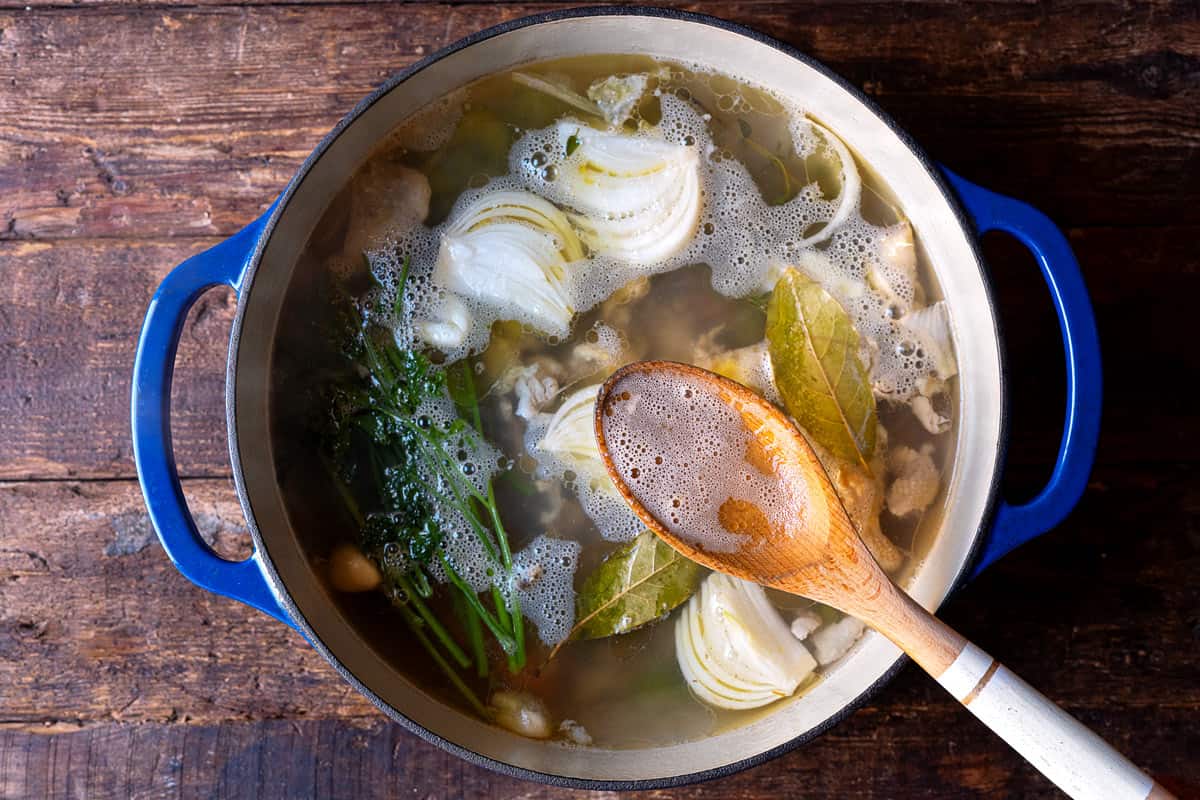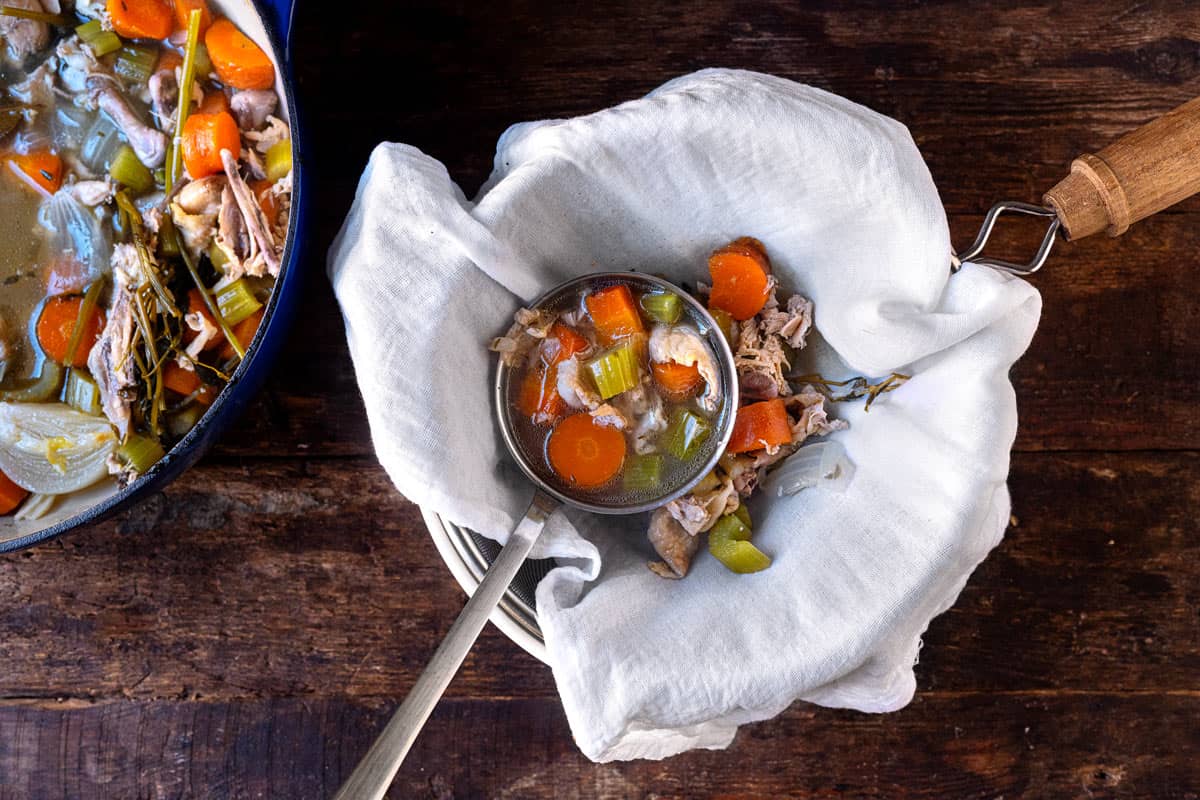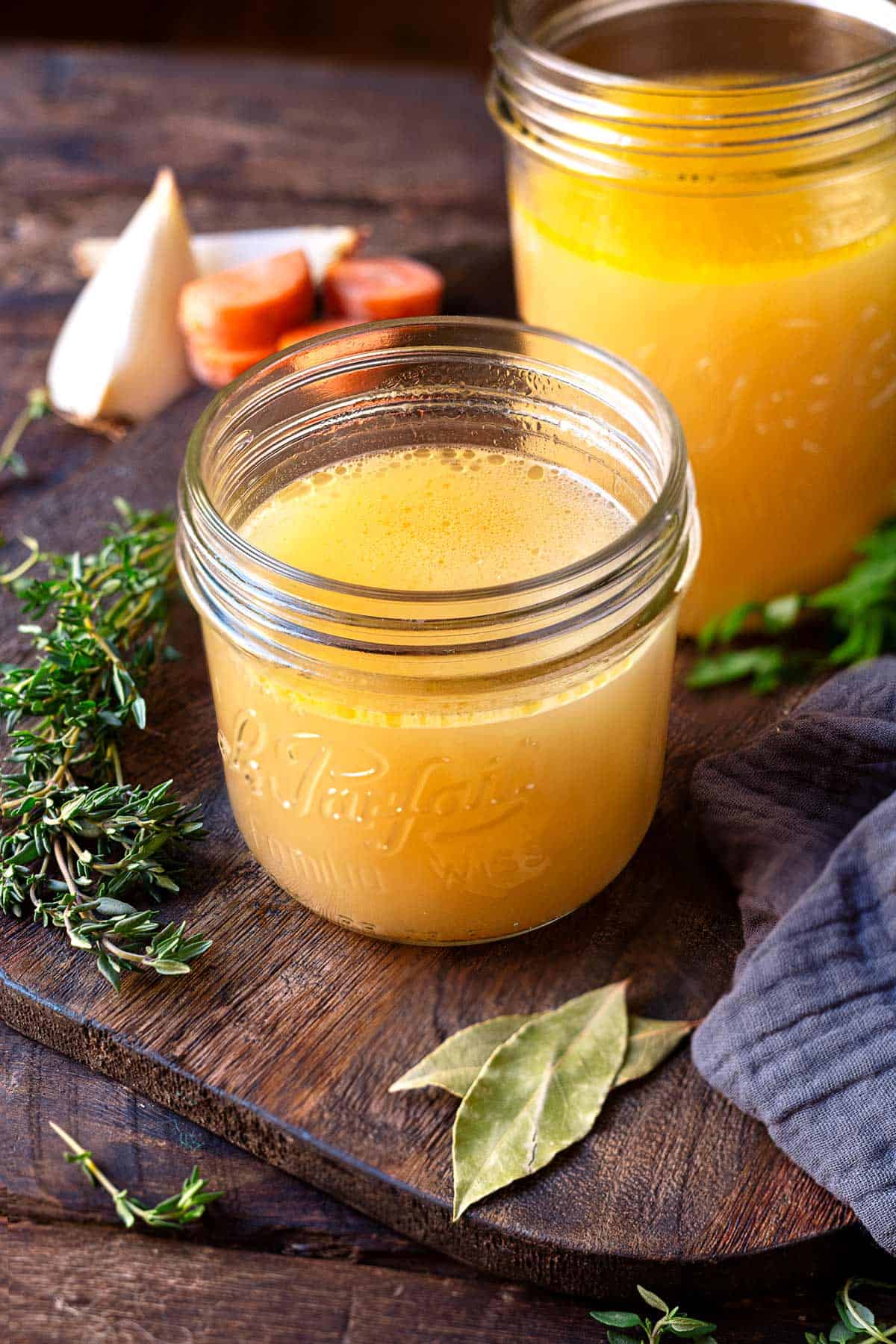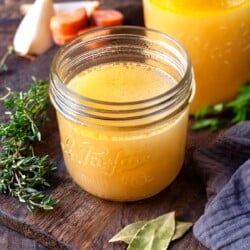Put that chicken carcass to good use and make homemade chicken stock! You just need a little time, chicken bones, carrots, celery, and onion. Before you know it, that golden elixir is ready for soups, stews, or pan sauces. Learning how to make chicken stock is easier than you think!

When my life was less busy and slightly quieter, I would make chicken stock while my children napped and I wrote my book or developed recipes for magazines and websites.
This was less a desire and more a need to be resourceful and pinch pennies while eating well. Simmering a batch of homemade chicken stock to use in soup recipes has since become a regular habit folded into the fabric of my life, not quite like breathing but more like making my bed or dropping my kids off at school.
Most chicken stock is made from bones and random scraps of vegetables and this recipe follows suit. You can make it in a stock pot on the stove top or in a slow cooker (more on that later).
In my home I usually add celery, onion and carrots, along with a few herbs and spices for good measure. But truthfully, there are no rules when it comes to what one can add to a pot of chicken bones. Add roasted garlic if you want it sweeter and caramelized, add ginger if you want a little bite, or fennel for a hint of anise.
Like homemade Vegetable Broth, making homemade chicken stock is an easy way to save money, use up what you have on hand and create something healthy and delicious while you’re at it. Use it in soups like Pastina, Avgolemono, White Bean and Kale Soup, Ratatouille, Chicken Gnocchi Soup, or Italian Wedding Soup. Sip on a cup of warm stock when you’re feeling under the weather or freeze it in an ice cube tray to use in pan sauces like in this Skillet Onion Chicken recipe.
Table of Contents
- What’s in Chicken Stock?
- How to Make Chicken Stock
- Chicken Stock Flavor Variations
- Tips for Making Homemade Chicken Stock
- How to Make Chicken Stock in a Slow Cooker
- What is the Difference Between Chicken Stock and Chicken Broth?
- Soothing Chicken Soup Recipes
- The Mediterranean Dish Cookbook
- How to Make Chicken Stock Recipe

What’s in Chicken Stock?
Basic chicken stock is really just bones and water, but dressing it up with a few herbs and vegetables just increases the flavor and complexity of the stock. When I’m cooking other dishes, I often save the scraps from chopping vegetables and put them in the freezer. When I’m ready to make stock, most of the ingredients are already there.
- Chicken carcass: I roast a chicken about once a week, but you can also use a rotisserie chicken you pick up from the store.
- Celery, carrots, onion: This is a pretty classic chicken stock combination used to impart flavor and the base of many soups.
- Garlic: Technically garlic is optional, use as much or as little as you’d like.
- Fresh thyme: I like fresh thyme because it’s easier to strain from the broth and I think it leaves a fresher tasting stock. You could also use 1 teaspoon of dried thyme leaves, just not powdered thyme. It will give the stock a muddy color.
- Bay leaves: Bay leaves lend a floral sweetness to the stock.
- Parsley stems: I use the stems because they have more oils than the leaves, and stock is a great way to use them up.
- 10 peppercorns (optional): I like a little spice and I always have whole peppercorns on hand. If you have them, use them. If you don’t, that’s OK.
How to Make Chicken Stock
Learning how to make chicken stock is easy. To make homemade chicken stock, place chicken bones, vegetables, herbs and spices into a large pot. Cover with cold water then simmer for about 3 hours. Let it cool, then skim the fat. Store in the refrigerator for up to 5 days or in the freezer for up to 6 months.
- Strip the chicken carcass of meat: This is hardly delicate work. You have to be willing to get your hands dirty to pull and peel the meat off the bones. Don’t forget to flip the bird over and pull the meat from the underside. There is plenty there. Transfer the meat to a container and keep in the fridge. Use it in soup, chicken salad, or to top a bed of greens. Now to address the bones.
- Make the stock: Into a large stock pot or Dutch oven add the chicken carcass – bones, skin and any random bits. Add the chopped celery, carrots, onion, garlic, thyme, bay leaves, parsley stems and peppercorns if using.

- Cover with cold water and simmer: Pour 10 cups of cold water over the ingredients in the stockpot and turn the heat to medium, just until you see a low boil, then reduce to medium low (or whatever temp you need to keep the stove at for a gentle simmer). You want the stock to simmer and never boil for any length of time because boiling can cause the fat and proteins to emulsify and give you dark, greasy stock. Cover with a lid.
- Skim the stock: Simmer on medium low for the next 3 hours. Check every 45 minutes or so and use a spoon to skim any foam that may form off the surface. This is not an exact science. If you lose track of time, and it simmers for 4 hours that’s Ok. You’ll just have a more concentrated stock and might need to add water. If you’re short on time and you only have 2 hours then you’ll just have a lighter stock. That’s Ok too. There is no room for perfectionists in stock making!

- Strain the stock: Layer a fine mesh strainer with cheesecloth. Set it over a large bowl, then ladle the stock into the lined strainer. Press on the solids to release any additional liquid. When it’s done you should have between 5 and 6 cups of stock depending upon how much it has reduced.

- Use, store or freeze: Now that you’ve made this golden elixir with bones and scraps, use it in your next batch of soup or freeze it for a rainy day. Transfer the stock to small containers so it cools down faster. Let it cool completely then cover and transfer to the fridge. Once stock sits in the fridge for a few hours or overnight a fat layer will form on the top. Go ahead and remove that fat layer. The stock will be gelatinous and wobbly when cold. that’s a good thing. Use it within 5 days or freeze it for up to six months.
Chicken Stock Flavor Variations
Get creative when it comes to adding herbs, spices, and aromatics to chicken stock. Here are are few ideas to get you started:
- Use the base recipe here, then add 1 leek, 1 sprig of rosemary and a handful of mushroom stems
- Swap the thyme for dill
- Swap the thyme for 1 inch of ginger and a small chili or mild jalapeño
- Add chopped fennel bulb and three whole cloves
- Add crushed cardamom pods
Tips for Making Homemade Chicken Stock
I’m not too persnickety when it comes to making homemade chicken stock, but there are a few basic tips to help make your chicken stock the best it can be.
Don’t Boil Stock: It’s best to make sure stock doesn’t boil for any length of time. Bring it up to a low boil, then quickly bring it down to a simmer. Extensive boiling will cause the fat to emulsify and leave your stock dingy with a greasy mouthfeel.
Skip the Salt: Homemade chicken stock is a base recipe you can build into other recipes like soups, stews, and pan sauces. For that reason you want to leave it unsalted. Should you reduce the stock or use it in other recipes with salt then you run the risk of the dish being too salty.
Use Cold Water to Start: Cold water helps to extract more flavor from the vegetables. Hot water causes the starch in the vegetables to expand and gel, limiting the amount of flavor that can be extracted. This is a little chefy, I will admit, and the average person probably doesn’t notice, but as my mom would say, “Any job worth doing is worth doing well.”
Cool Completely: Once you’ve strained the stock, transfer it to small containers and let it cool completely. Cover and place in the fridge. Skim the fat off the top, then store for another 4 days or place in the freezer for up to six months.

How to Make Chicken Stock in a Slow Cooker
Now that my children are older and I’m scooting them off to one activity or another, I find using a slow cooker to make chicken stock saves me time and lets me leave the house!
To make slow cooker chicken stock:
- Add all of the ingredients into your slow cooker.
- Cover with 6 cups of water and turn to high. If you’re going to be around in an hour to reduce it to low, if not, then just set it low. You don’t need as much water when making it in a slow cooker because you don’t have as much evaporation.
- Secure the lid and let it bubble away all day while you’re at work or overnight while you’re sleeping.
- When ready, pour the stock through a fine mesh strainer.
- Let it cool completely then store it in the fridge or freeze it.
What is the Difference Between Chicken Stock and Chicken Broth?
Chicken stock is made from bones and chicken broth is made from meat. Clever marketing campaigns using phrases like, “Bone Broth” (our love of alliteration is strong), can cause confusion, but if it’s made from bones it’s actually stock.
If you read chefy books or manuals you will also see a reference to salt or no salt being a defining factor in stock vs. broth. This is because technically one is used for soup, and the other is meant to be reduced for pan sauces, but really most home cooks don’t care. I skip the salt when making stock or broth and just salt the recipe I’m using it in.
Soothing Chicken Soup Recipes
Soups and Stews
White Bean and Kale Soup with Chicken
Soups and Stews
Mediterranean-Style Turmeric Lemon Chicken Soup
Soups and Stews
Lemon Chicken Orzo Soup
Browse all Mediterranean recipes.
Visit Our Shop.
The Mediterranean Dish Cookbook
Enjoy cross-culturally inspired dishes from throughout the Mediterranean using easy-to-find ingredients and easy-to-follow recipes!

How to Make Chicken Stock

Ingredients
- 1 chicken carcass
- 2 celery ribs, chopped
- 2 large carrots, chopped
- 1 onion, quartered
- 3 cloves garlic, crushed
- 4 sprigs fresh thyme
- 2 bay leaves
- Parsley stems
- 10 peppercorns, optional
Instructions
- Strip the chicken carcass of meat: Use your hands to pull and peel the meat off the bones. Transfer the meat to a container and keep in the fridge. Use it in soup, chicken chicken salad, or to top a bed of greens.
- Make the stock: Into a large stock pot or Dutch oven add the chicken carcass – bones, skin and any random bits. Add the chopped celery, carrots, onion, garlic, thyme, bay leaves, parsley stems and peppercorns if using.
- Cover with water and simmer: Pour 10 cups of cold water over the ingredients in the stockpot and turn the heat to medium, just until it begins to have a low boil, then reduce to medium low (or whatever temp you need to keep the stove at for a gentle simmer). You want the stock to simmer and never boil. Boiling can cause the fat and proteins to emulsify and give you dark, greasy stock.
- Skim the stock: Push the ingredients down to make sure they are submerged in the water and let the stock simmer on medium low for the next 3 hours. Cover with a lid. Check every 45 minutes or so and use a spoon to skim any foam that may form off the surface. This is not an exact science. If you lose track of time, and it simmers for 4 hours that’s Ok. You’ll just have a more concentrated stock and might need to add water. If you’re short on time and you only have 2 hours then you’ll just have a lighter stock. That’s Ok too. There is no room for perfectionists in stock making!
- Strain the stock: Layer a fine mesh strainer with cheesecloth. Set it over a large bowl, then ladle the stock into the lined strainer. Press on the solids to release any additional liquid. When it’s done you should have between 5 and 6 cups of stock depending upon how much it has reduced.
- Use, store or freeze: Transfer the stock to small containers so it cools down faster. Let it cool completely then cover and transfer to the fridge. Once stock sits in the fridge for a few hours or overnight a fat layer will form on the top. Go ahead and remove that fat layer. The stock will be gelatinous and wobbly when cold. that’s a good thing. Use it within 5 days or freeze it for up to six months.
Notes
- Short on time? Make chicken stock in the slow cooker. Add all of the ingredients into your slow cooker. Cover with 6 cups of water and turn to high. If you’re going to be around in an hour, reduce to low. If not then just set it to low at the outset. Secure the lid and let it bubble away all day while you’re at work or overnight while you’re sleeping. When ready, pour the stock through a fine mesh strainer and cool.
- Cheesecloth: I like to use cheesecloth just for an extra layer of straining, but if you don’t have any a fine mesh sieve will do just fine all on its own.
- Visit our shop to browse quality Mediterranean ingredients including olive oils, honey, jams and spices.







Delicious and easy.
Turned out with great flavor and about 12 cups! Put in 4 gallon bags in freezer and ready to be used when I need it!
Such a great idea! Happy cooking 🙂
I’ve had a chicken carcass in the fridge since Sunday, can I use this still to make stock tomorrow (Thursday)?
Hi, Becca. Most sources say it’s okay to keep a carcass to us for making broth in the fridge for 3-4 days, so I would proceed with caution here since you’re nearing that cutoff. In the future, if you don’t plan to use a carcass right aways, we highly recommend you put it in the freezer after it cools.
This was clear , great tips and wonderful knowledge so excited to remake with the kiddos thanks much
What do you do with the veggies used in making stock? Throw them away?
Hi, Jessica — I’m Summer and I work here at The Mediterranean Dish. Yes, I just dispose of them along with the leftover chicken bones. All the flavor has been pulled into the stock and they are pretty mushy.